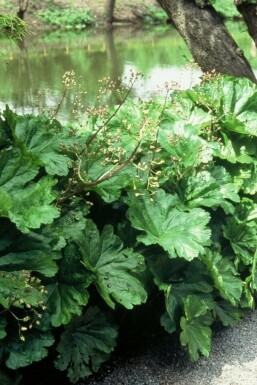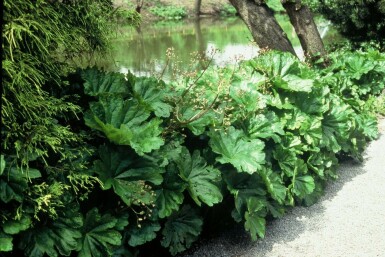

100cm




The Darmera, commonly known as Indian rhubarb, is a remarkable perennial that hails from the Western United States and is celebrated for its distinctive, rounded green foliage. This plant, which does not bear fruit, unfolds a striking floral display in hues of pink and white, creating a captivating visual spectacle. Although it is not evergreen and does not exude fragrance, the Darmera's aesthetic appeal is undiminished, making it a splendid addition to any garden that seeks to add a touch of natural elegance and charm.


100cm




The genus Darmera, commonly known as Indian rhubarb, is a striking addition to any garden with its lush foliage and charming floral displays. Originating from the western regions of the United States, Darmera is well-suited to gardeners seeking a plant that offers both aesthetic appeal and ease of maintenance. With its bushy and spreading growth habit, Darmera provides a touch of wilderness and artistic flair when placed in a border or grouped with other plants.
Darmera is noted for its robust and decorative qualities, which make it an ideal choice for gardeners looking to enhance their outdoor spaces. Here are some of the key features of this enchanting genus:
For those considering integrating Darmera into their garden, the following tips will ensure the successful cultivation and enjoyment of this genus:
With its appealing attributes and straightforward care requirements, Darmera serves as an excellent choice for those desiring to infuse their gardens with natural beauty and seasonal interest.
Embrace the lush spectacle of the Darmera peltata, commonly known as the Indian rhubarb, which graces gardens with its grand umbrella-shaped leaves and charming clusters of pink flowers. This majestic perennial thrives in moist conditions, making it a splendid addition to waterside plantings or damp, shaded garden spots where its full splendor can truly be appreciated.
We would like to provide some tips on how to plant and care for a Darmera. By following these tips, you can be sure to enjoy your Darmera for a long time.
Thriving in partial shade to full shade, Darmera is an adaptable specimen, suited for a variety of garden settings. It prospers in moist, well-drained soils, where its lush green foliage can spread into a bushy formation. While it can tolerate different soil types, the area should be protected from the harsh afternoon sun to preserve the vibrancy of its leaves, which transition to a striking red hue come autumn. Given its preference for cooler, shaded environments, this plant is ideal for understory locations or north-facing garden spots that offer respite from the intense heat of the day.
For optimal establishment in the garden, Darmera should be planted in a location that offers partial shade to full shade, which mimics its native habitat in the Western USA. The soil should be well-drained, yet this species is adaptable to various soil types. When planting, ensure there is ample space for the bushy spreading growth habit to flourish, aiming for a final height of about 1 meter. Regular watering is necessary to maintain average moisture levels, especially during the establishment period and in the absence of sufficient rainfall. Spring or autumn is the best time for planting or propagating through division, promoting vigorous growth and a healthy plant structure.
To support the vigorous growth and stunning floral display of Darmera, a balanced fertilizing regimen is essential. Apply a complete, all-purpose fertilizer in early spring as new growth appears, providing the necessary nutrients for the upcoming blooming season. A second application of fertilizer is recommended in late summer to fortify the plant as it prepares for the autumn when the foliage transforms into a striking red hue.
Choose a fertilizer with an equal balance of nitrogen, phosphorus, and potassium to promote healthy leaves and robust flowers. Be sure to follow the manufacturer's guidelines for application rates, as over-fertilizing can lead to excessive foliage at the expense of flower production. Water the plant thoroughly after fertilizing to help distribute the nutrients in the soil.
Pruning is a minimal requirement for the Darmera, primarily to maintain its natural bushy spreading growth habit and to remove any spent flower stems. After the Darmera has bloomed in spring, simply cut back the dead flower stalks to their base, encouraging the lush foliage to take center stage. Occasionally, as the plant matures, selectively thin out overcrowded growth to enhance air circulation and light penetration throughout the plant. This should be done post-flowering to avoid disrupting the next season's bloom.
To thrive, Darmera requires consistent moisture, particularly during the growing season. It is important to ensure the soil remains well-drained yet does not completely dry out, as the species is not drought-resistant. Regular watering will support the lush, bushy growth and the vibrant foliage transitions from green in summer to a striking red in autumn. During peak flowering months, adequate hydration is key to the development of the plant's characteristic pink and white blooms. Watering should be adjusted based on rainfall and lessened as the plant enters dormancy post-flowering season.
Enthusiasts of unique foliage will appreciate the Darmera for its large, rounded leaves that can add a dramatic touch to any water garden or moist landscape area. As the seasons change, the foliage transforms, offering a dynamic display from spring to fall. The plant's robust nature allows it to thrive in damper soils, where many other species may not prosper, making it a valuable addition to diverse garden settings.
To maintain the health and vigor of Darmera, division should be carried out during the cooler months of spring or autumn. This procedure involves carefully lifting the plant from the soil and separating it into smaller sections, ensuring each division has a portion of the root system intact. Replant these divisions promptly, allowing them adequate space to develop. The division not only rejuvenates the Darmera but also helps control its size and spread, permitting gardeners to manage its bushy growth habit effectively and maintain the aesthetic appeal of their borders and group plantings.
The Darmera, with its striking, rounded leaves and charming pink blooms, is an exceptional addition to any garden. This plant thrives in moist conditions, making it an ideal choice for waterside planting or as a natural highlight in a shade garden. Its robust nature and lush foliage create a truly captivating display.
